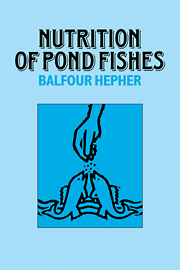Book contents
- Frontmatter
- Contents
- List of symbols
- Preface
- Introduction
- Part I FOOD REQUIREMENT
- 1 The balance of energy
- 2 Ingestion, digestion and absorption of food
- 3 Energy pathways
- 4 Maintenance
- 5 Growth
- 6 Requirement for protein
- 7 Other essential nutrients
- Part II FOOD SOURCES AND THEIR UTILIZATION
- Appendixes
- References
- Systematic index
- Subject index
1 - The balance of energy
Published online by Cambridge University Press: 06 August 2010
- Frontmatter
- Contents
- List of symbols
- Preface
- Introduction
- Part I FOOD REQUIREMENT
- 1 The balance of energy
- 2 Ingestion, digestion and absorption of food
- 3 Energy pathways
- 4 Maintenance
- 5 Growth
- 6 Requirement for protein
- 7 Other essential nutrients
- Part II FOOD SOURCES AND THEIR UTILIZATION
- Appendixes
- References
- Systematic index
- Subject index
Summary
The quantitative requirement of any food depends largely on its composition. The most efficient level of feeding is attained only when the correct supply of energy and essential nutrients is available in the proportions required by the fish for maintenance and growth. Any deviation from this ‘ideal’ composition will also change the quantitative food requirement. For the sake of clarity, it is necessary to separate the discussion of the quantitative aspects of feeding from the qualitative aspects. When dealing with the quantitative aspects it is usually assumed that the diet consumed corresponds to this ‘ideal’ composition. However, the effect of the composition of the diet actually consumed on the quantitative requirements must also be taken into account.
In the transformation of food energy to net energy available for metabolism and growth, a considerable portion is lost. Although some energy loss is unavoidable, it should obviously be minimized. This can only be done if the processes by which energy is lost have been studied and the amount lost can be estimated. Figure 1 presents graphically the transformation of food energy to net energy for maintenance and growth, and indicates the losses incurred during these transformations.
The digestible energy (DE) is part of the food energy which is absorbed by the fish, while the energy egested in the faeces (Ef) is lost. Some of the digestible energy is lost through the excretion of catabolites in the urine and through the gills (Em).
- Type
- Chapter
- Information
- Nutrition of Pond Fishes , pp. 5 - 15Publisher: Cambridge University PressPrint publication year: 1988



